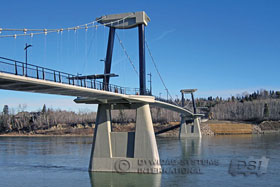DSI Mining Canada
Fort Edmonton, Canada: First Cable Suspension Bridge stabilized using DYWIDAG Systems
In June 2011, the first cable suspension bridge was opened in the Canadian city of Edmonton, Alberta.
 The bridge is located at the south-west corner of Historic Fort Edmonton’s park and is part of the city’s Ribbon of Green Project. The project’s aim is to make the meadows and woods in the river valley accessible to the public.
The bridge is located at the south-west corner of Historic Fort Edmonton’s park and is part of the city’s Ribbon of Green Project. The project’s aim is to make the meadows and woods in the river valley accessible to the public.
Construction of the 246m long pedestrian bridge began in August 2008. The bridge has a center span of 138m and features a unique conceptual design with viewing platforms at each pier. It utilizes only two piers that are positioned in the river bed at distances of approx. 30 to 40m from the banks. The piers were built in this manner in order to minimize their impact on nature.
As the upper layers of soil in the river bed did not have enough load-bearing capacity to accommodate the expected loads, the foundations of both bridge piers in the river bed were designed as deep foundations. For this purpose, reinforced concrete caissons were embedded and filled in the river bed at a depth of approx. 12.5m. The dynamic loads of the structure are transferred into the soil above the caissons.
Subsequently, the two piers were erected on the foundations using reinforced concrete up to the height of the bridge deck. The deck was built using the segmental construction method with 3m long reinforced precast concrete panels that were longitudinally tensioned using strand tendons.
Due to the changing weather conditions, it was not possible to use large cranes in the middle of the river to place the precast segments. Consequently, the segments were put in place using temporary post-tensioning tendons across the main span on which a trolley system was used to transport the segments from shore to their final locations.
Above the bridge deck, the two piers consist of divided steel pylons leaning towards each other. At the top of the pylons, two post-tensioned concreted pier caps are located which the two main suspension cables run over. The two main suspension cables run parallel to the bridge deck, accommodate the loads of the vertical hangers and carry the tensile force of the bridge deck. The two main cables are tied back into separate anchor blocks located on shore.
DSI Canada supplied DYWIDAG Bar Anchors, Ø 36mm, for the abutments. In addition, DSI supplied and installed all of the post-tensioning systems. This included 12-0.6" to 27-0.6" DYWIDAG Strand Tendons in the bridge deck, DYWIDAG Bar Tendons, Ø 36mm for the concreted pier caps and DYWIDAG Bar Tendons, Ø 46mm for the anchor blocks at the ends of the main cables.
Thanks to the help and advice of experienced DSI engineers, the Canadian construction team was able to master the unusual challenge without any problems.
DSI Unit DYWIDAG-Systems International Canada Ltd., Eastern Division, Canada
Owner City of Edmonton, Canada +++ Contractor Alberco Construction Ltd., Canada +++ Consulting Engineers CH2M HILL, Canada
DSI Unit DYWIDAG-Systems International Canada Ltd., Eastern Division, Canada
DSI Scope Supply of DYWIDAG Bar Anchors, Ø 36 mm, DYWIDAG Strand Post-Tensioning Tendons, 12-0.6" to 27-0.6" and of DYWIDAG Bar Tendons, Ø 36 and 46mm
Source: http://www.dsiunderground.com/references/details/article/fort-edmonton-canada.html

|
Your Career at DSI
As a global group, we offer our employees an international environment and exposure to renowned projects and customers in both Construction and Underground Mining.